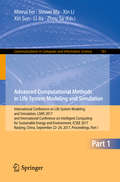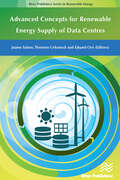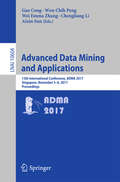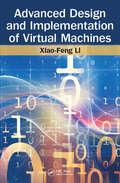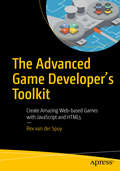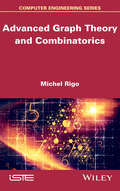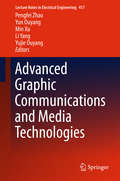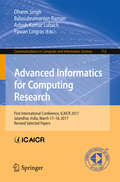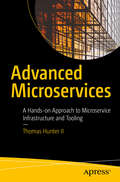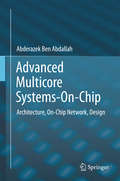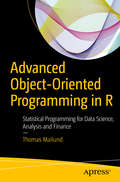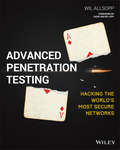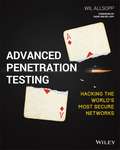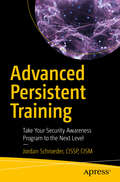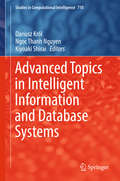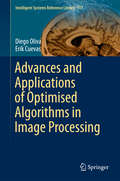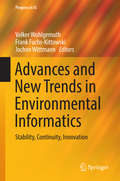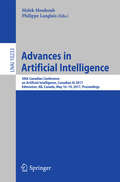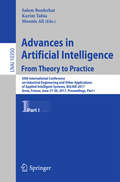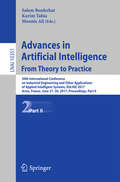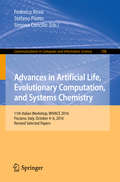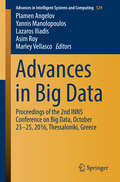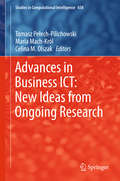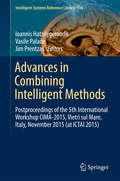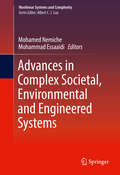- Table View
- List View
Advanced Computational Methods in Life System Modeling and Simulation: International Conference on Life System Modeling and Simulation, LSMS 2017 and International Conference on Intelligent Computing for Sustainable Energy and Environment, ICSEE 2017, Nanjing, China, September 22-24, 2017, Proceedings, Part I (Communications in Computer and Information Science #761)
by Xin Li Xin Sun Zhou Su Minrui Fei Shiwei Ma Li JiaThe three-volume set CCIS 761, CCIS 762, and CCIS 763 constitutes the thoroughly refereed proceedings of the International Conference on Life System Modeling and Simulation, LSMS 2017, and of the International Conference on Intelligent Computing for Sustainable Energy and Environment, ICSEE 2017, held in Nanjing, China, in September 2017. The 208 revised full papers presented were carefully reviewed and selected from over 625 submissions. The papers of this volume are organized in topical sections on: Biomedical Signal Processing; Computational Methods in Organism Modeling; Medical Apparatus and Clinical Applications; Bionics Control Methods, Algorithms and Apparatus; Modeling and Simulation of Life Systems; Data Driven Analysis; Image and Video Processing; Advanced Fuzzy and Neural Network Theory and Algorithms; Advanced Evolutionary Methods and Applications; Advanced Machine Learning Methods and Applications; Intelligent Modeling, Monitoring, and Control of Complex Nonlinear Systems; Advanced Methods for Networked Systems; Control and Analysis of Transportation Systems; Advanced Sliding Mode Control and Applications; Advanced Analysis of New Materials and Devices; Computational Intelligence in Utilization of Clean and Renewable Energy Resources; Intelligent Methods for Energy Saving and Pollution Reduction; Intelligent Methods in Developing Electric Vehicles, Engines and Equipment; Intelligent Computing and Control in Power Systems; Modeling, Simulation and Control in Smart Grid and Microgrid; Optimization Methods; Computational Methods for Sustainable Environment.
Advanced Concepts for Renewable Energy Supply of Data Centres
by Jaume Salom Thorsten Urbaneck Eduard OróThe rapid increase of cloud computing, high performance computing (HPC) and the vast growth in Internet and Social Media use have aroused the interest in energy consumption and the carbon footprint of Data Centres. Data Centres primarily contain electronic equipment used for data processing (servers), data storage (storage equipment), and communications (network equipment). Collectively, this equipment processes, stores, and transmits digital information and is known as information technology (IT) equipment. Advanced Concepts for Renewable Energy Supply of Data Centres introduces a number of technical solutions for the supply of power and cooling energy into Data Centres with enhanced utilisation of renewable energy sources in order to achieve low energy Data Centres. Because of the high energy density nature of these unique infrastructures, it is essential to implement energy efficiency measures and reduce consumption before introducing any renewable energy source. A holistic approach is used with the objective of integrating many technical solutions such as management of the IT (Information Technology) load, efficient electrical supply to the IT systems, Low-Ex air-conditioning systems, interaction with district heating and cooling networks, re-use of heat, free cooling (air, seawater, groundwater), optimal use of heat and cold storage, electrical storage and integration in smart grids. This book is therefore a catalogue of advanced technical concepts that could be integrated into Data Centres portfolio in order to increase the overall efficiency and the share of renewable energies in power and cooling supply. Based on dynamic energy models implemented in TRNSYS some concepts are deeply evaluated through yearly simulations. The results of the simulation are illustrated with Sankey charts, where the energy flows per year within the subsystems of each concept for a selected scenario are shown, and graphs showing the results of parametric analysis. A set of environmental metrics (as the non-renewable primary energy) and financial metrics (CAPEX and OPEX) as well of energy efficiency metrics like the well-known PUE, are described and used to evaluate the different technical concepts.
Advanced Data Mining and Applications: 13th International Conference, ADMA 2017, Singapore, November 5–6, 2017, Proceedings (Lecture Notes in Computer Science #10604)
by Gao Cong, Wen-Chih Peng, Wei Emma Zhang, Chengliang Li and Aixin SunThis book constitutes the refereed proceedings of the 13th International Conference on Advanced Data Mining and Applications, ADMA 2017, held in Singapore in November 2017. The 20 full and 38 short papers presented in this volume were carefully reviewed and selected from 118 submissions. The papers were organized in topical sections named: database and distributed machine learning; recommender system; social network and social media; machine learning; classification and clustering methods; behavior modeling and user profiling; bioinformatics and medical data analysis; spatio-temporal data; natural language processing and text mining; data mining applications; applications; and demos.
Advanced Design and Implementation of Virtual Machines
by Xiao-Feng LiAlong with the increasingly important runtime engines pervasive in our daily-life computing, there is a strong demand from the software community for a solid presentation on the design and implementation of modern virtual machines, including the Java virtual machine, JavaScript engine and Android execution engine. The community expects to see not only formal algorithm description, but also pragmatic code snippets; to understand not only research topics, but also engineering solutions. This book meets these demands by providing a unique description that combines high level design with low level implementations and academic advanced topics with commercial solutions. This book takes a holistic approach to the design of VM architecture, with contents organized into a consistent framework, introducing topics and algorithms in an easily understood step by step process. It focuses on the critical aspects of VM design, which are often overlooked in other works, such as runtime helpers, stack unwinding and native interface. The algorithms are fully illustrated in figures and implemented in easy to digest code snippets, making the abstract concepts tangible and programmable for system software developers.
The Advanced Game Developer's Toolkit
by Rex van der Spuy<P>Master the most important skills and techniques you need to know for professional HTML5 and JavaScript 2D game development. This book delves into many of the great classic techniques of video game design. <P> You’ll discover how to develop games and game levels using Tiled Editor, how to implement tile-based collision, how to design advanced pathfinding and enemy AI systems, the fundamentals of broad-phase collision, and how to make isometric games. All the techniques and supporting code are explained in an easy-to-understand manner and written in a general way so that they can be applied to any game engine or technology that you’re comfortable using. <P> You'll find detailed working examples, with dozens of illustrations and many concepts you can freely apply to your own projects. All the math and programming techniques are elaborately explained and examples are open-ended to encourage you to think of original ways to use these techniques in your own games. You can use what you learn in this book as the basis for making games for desktops, mobile phones, tablets, or the Web. <P> The Advanced Game Developer's Toolkit is a great next step if you already have some JavaScript game-making- experience, or a great continuation if you've already read Advanced Game Design with HTML5 and JavaScript by the same author.
Advanced Graph Theory and Combinatorics
by Michel RigoAdvanced Graph Theory focuses on some of the main notions arising in graph theory with an emphasis from the very start of the book on the possible applications of the theory and the fruitful links existing with linear algebra. The second part of the book covers basic material related to linear recurrence relations with application to counting and the asymptotic estimate of the rate of growth of a sequence satisfying a recurrence relation.
Advanced Graphic Communications and Media Technologies (Lecture Notes in Electrical Engineering #417)
by Min Xu Li Yang Yun Ouyang Yujie Ouyang Pengfei ZhaoThis book includes a selection of reviewed papers presented at the 2016 China Academic Conference on Printing, Packaging Engineering & Media Technology, held on November 25-27, 2016 in Xi'an, China. The conference was jointly organized by China Academy of Printing Technology, Xi'an University of Technology and Stuttgart Media University of Germany. The proceedings cover the recent outcomes on color science and technology, image processing technology, digital media technology, digital process management technology in packaging and packaging etc. They will be of interest to university researchers, R&D engineers and graduate students in graphic communications, packaging, color science, image science, material science, computer science, digital media and network technology fields.
Advanced Informatics for Computing Research: First International Conference, ICAICR 2017, Jalandhar, India, March 17–18, 2017, Revised Selected Papers (Communications in Computer and Information Science #712)
by Pawan Lingras Balasubramanian Raman Dharm Singh Ashish Kumar LuhachThis book constitutes the refereed proceedings of the First International Conference on Advanced Informatics for Computing Research , ICAICR 2017, held in Jalandhar, India, in March 2017. The 32 revised full papers presented were carefully reviewed and selected from 312 submissions. The papers are organized in topical sections on computing methodologies, information systems, security and privacy, network services.
Advanced Microservices: A Hands-on Approach to Microservice Infrastructure and Tooling
by Thomas Hunter IIUse the many types of tools required to navigate and maintain a microservice ecosystem. This book examines what is normally a complex system of interconnected services and clarifies them one at a time, first examining theoretical requirements then looking at concrete tools, configuration, and workflows. Building out these systems includes many concerns such as containerization, container orchestration, build pipelines and continuous integration solutions, automated testing, service discovery, logging and analytics. You will examine each of these tools and understand how they can be combined within an organization. You will design an automated build pipeline from Pull Request to container deployment, understand how to achieve High Availability and monitor application health with Service Discovery, and learn how to collaborate with other teams, write documentation, and describe bugs. Covering use of Jenkins, Docker, Kubernetes, the ELK stack (Elasticsearch, Logstash, and Kibana), and StatsD and Grafana for analytics, you will build on your existing knowledge of Service-Oriented Architecture and gain an advanced, practical understanding of everything from infrastructure development to team collaboration. What You'll Learn Design an API to be convenient for developers to consume. Deploy dynamic instances of Microservices and allow then to discover each other. Track the health of a Microservice and be notified in case of degraded performance. Write effective documentation and communicate efficiently with other teams. Who This Book Is For Those who would like a better understanding of System Oriented Architecture. Those who would like to break a monolith into smaller Microservices. Those who are familiar with Microservices and would like a better understanding of peripheral technologies.
Advanced Multicore Systems-On-Chip: Architecture, On-Chip Network, Design
by Abderazek Ben AbdallahFrom basic architecture, interconnection, and parallelization to power optimization, this book provides a comprehensive description of emerging multicore systems-on-chip (MCSoCs) hardware and software design. Highlighting both fundamentals and advanced software and hardware design, it can serve as a primary textbook for advanced courses in MCSoCs design and embedded systems. The first three chapters introduce MCSoCs architectures, present design challenges and conventional design methods, and describe in detail the main building blocks of MCSoCs. Chapters 4, 5, and 6 discuss fundamental and advanced on-chip interconnection network technologies for multi and many core SoCs, enabling readers to understand the microarchitectures for on-chip routers and network interfaces that are essential in the context of latency, area, and power constraints. With the rise of multicore and many-core systems, concurrency is becoming a major issue in the daily life of a programmer. Thus, compiler and software development tools are critical in helping programmers create high-performance software. Programmers should make sure that their parallelized program codes will not cause race condition, memory-access deadlocks, or other faults that may crash their entire systems. As such, Chapter 7 describes a novel parallelizing compiler design for high-performance computing. Chapter 8 provides a detailed investigation of power reduction techniques for MCSoCs at component and network levels. It discusses energy conservation in general hardware design, and also in embedded multicore system components, such as CPUs, disks, displays and memories. Lastly, Chapter 9 presents a real embedded MCSoCs system design targeted for health monitoring in the elderly.
Advanced Object-Oriented Programming in R: Statistical Programming for Data Science, Analysis and Finance
by Thomas MailundLearn how to write object-oriented programs in R and how to construct classes and class hierarchies in the three object-oriented systems available in R. This book gives an introduction to object-oriented programming in the R programming language and shows you how to use and apply R in an object-oriented manner. You will then be able to use this powerful programming style in your own statistical programming projects to write flexible and extendable software. After reading Advanced Object-Oriented Programming in R, you'll come away with a practical project that you can reuse in your own analytics coding endeavors. You'll then be able to visualize your data as objects that have state and then manipulate those objects with polymorphic or generic methods. Your projects will benefit from the high degree of flexibility provided by polymorphism, where the choice of concrete method to execute depends on the type of data being manipulated. What You'll Learn Define and use classes and generic functions using R Work with the R class hierarchies Benefit from implementation reuse Handle operator overloading Apply the S4 and R6 classes Who This Book Is For Experienced programmers and for those with at least some prior experience with R programming language.
Advanced Penetration Testing: Hacking the World's Most Secure Networks
by Wil AllsoppBuild a better defense against motivated, organized, professional attacks Advanced Penetration Testing: Hacking the World's Most Secure Networks takes hacking far beyond Kali linux and Metasploit to provide a more complex attack simulation. Featuring techniques not taught in any certification prep or covered by common defensive scanners, this book integrates social engineering, programming, and vulnerability exploits into a multidisciplinary approach for targeting and compromising high security environments. From discovering and creating attack vectors, and moving unseen through a target enterprise, to establishing command and exfiltrating data—even from organizations without a direct Internet connection—this guide contains the crucial techniques that provide a more accurate picture of your system's defense. Custom coding examples use VBA, Windows Scripting Host, C, Java, JavaScript, Flash, and more, with coverage of standard library applications and the use of scanning tools to bypass common defensive measures. Typical penetration testing consists of low-level hackers attacking a system with a list of known vulnerabilities, and defenders preventing those hacks using an equally well-known list of defensive scans. The professional hackers and nation states on the forefront of today's threats operate at a much more complex level—and this book shows you how to defend your high security network. Use targeted social engineering pretexts to create the initial compromise Leave a command and control structure in place for long-term access Escalate privilege and breach networks, operating systems, and trust structures Infiltrate further using harvested credentials while expanding control Today's threats are organized, professionally-run, and very much for-profit. Financial institutions, health care organizations, law enforcement, government agencies, and other high-value targets need to harden their IT infrastructure and human capital against targeted advanced attacks from motivated professionals. Advanced Penetration Testing goes beyond Kali linux and Metasploit and to provide you advanced pen testing for high security networks.
Advanced Persistent Threats: Discovering Flaws in the World's Most Secure Networks
by Wil AllsoppBuild a better defense against motivated, organized, professional attacks Advanced Penetration Testing: Hacking the World's Most Secure Networks takes hacking far beyond Kali linux and Metasploit to provide a more complex attack simulation. Featuring techniques not taught in any certification prep or covered by common defensive scanners, this book integrates social engineering, programming, and vulnerability exploits into a multidisciplinary approach for targeting and compromising high security environments. From discovering and creating attack vectors, and moving unseen through a target enterprise, to establishing command and exfiltrating data—even from organizations without a direct Internet connection—this guide contains the crucial techniques that provide a more accurate picture of your system's defense. Custom coding examples use VBA, Windows Scripting Host, C, Java, JavaScript, Flash, and more, with coverage of standard library applications and the use of scanning tools to bypass common defensive measures.
Advanced Persistent Training: Take Your Security Awareness Program to the Next Level
by Jordan SchroederGain greater compliance with corporate training by addressing the heart of the very awareness vs. compliance problem: people are human. People have incredible strengths and incredible weaknesses, and as a Information Security professional, you need to recognize and devise training strategies that take advantage of both. This concise book introduces two such strategies, which combined, can take a security awareness program to the next level of effectiveness, retention, compliance, and maturity. Security policies and procedures are often times inconvenient, technically complex, and hard to understand. Advanced Persistent Training provides numerous tips from a wide range of disciplines to handle these especially difficult situations. Many information security professionals are required by regulation or policy to provide security awareness training within the companies they work for, but many believe that the resulting low compliance with training does not outweigh the costs of delivering that training. There are also many who believe that this training is crucial, if only it could be more effective. What you will learn: Present awareness materials all year-round in a way that people will really listen. Implement a "behavior-first" approach to teaching security awareness. Adopt to gamification the right way, even for people who hate games. Use tips from security awareness leaders addressing the same problems you face. Who is this book for Security awareness professionals or IT Security professionals who are tasked with teaching security awareness within their organization.
Advanced Topics in Intelligent Information and Database Systems (Studies in Computational Intelligence #710)
by Ngoc Thanh Nguyen Dariusz Król Kiyoaki ShiraiThis book presents recent research in intelligent information and database systems. The carefully selected contributions were initially accepted for presentation as posters at the 9th Asian Conference on Intelligent Information and Database Systems (ACIIDS 2017) held from to 5 April 2017 in Kanazawa, Japan. While the contributions are of an advanced scientific level, several are accessible for non-expert readers. The book brings together 47 chapters divided into six main parts: * Part I. From Machine Learning to Data Mining. * Part II. Big Data and Collaborative Decision Support Systems, * Part III. Computer Vision Analysis, Detection, Tracking and Recognition, * Part IV. Data-Intensive Text Processing, * Part V. Innovations in Web and Internet Technologies, and * Part VI. New Methods and Applications in Information and Software Engineering. The book is an excellent resource for researchers and those working in algorithmics, artificial and computational intelligence, collaborative systems, decision management and support systems, natural language processing, image and text processing, Internet technologies, and information and software engineering, as well as for students interested in such research areas.
Advances and Applications of Optimised Algorithms in Image Processing (Intelligent Systems Reference Library #117)
by Erik Cuevas Diego OlivaThis book presents a study of the use of optimization algorithms in complex image processing problems. The problems selected explore areas ranging from the theory of image segmentation to the detection of complex objects in medical images. Furthermore, the concepts of machine learning and optimization are analyzed to provide an overview of the application of these tools in image processing. The material has been compiled from a teaching perspective. Accordingly, the book is primarily intended for undergraduate and postgraduate students of Science, Engineering, and Computational Mathematics, and can be used for courses on Artificial Intelligence, Advanced Image Processing, Computational Intelligence, etc. Likewise, the material can be useful for research from the evolutionary computation, artificial intelligence and image processing communities.
Advances and New Trends in Environmental Informatics: Stability, Continuity, Innovation (Progress in IS)
by Jochen Wittmann Volker Wohlgemuth Frank Fuchs-KittowskiThis book presents the latest findings and ongoing research in the field of green information systems as well as green information and communication technology (ICT). It provides insights into a whole range of cross-cutting concerns in ICT and environmental sciences and showcases how information and communication technologies allow environmental and energy efficiency issues to be handled effectively. Offering a selection of extended and reworked contributions to the 30th International Conference EnviroInfo 2016, it is essential reading for anyone wanting to extend their expertise in the area.
Advances in Artificial Intelligence: 30th Canadian Conference on Artificial Intelligence, Canadian AI 2017, Edmonton, AB, Canada, May 16-19, 2017, Proceedings (Lecture Notes in Computer Science #10233)
by Malek Mouhoub Philippe LanglaisThis book constitutes the refereed proceedings of the 30th Canadian Conference on Artificial Intelligence, Canadian AI 2017, held in Edmonton, AB, Canada, in May 2017. The 19 regular papers and 24 short papers presented together with 6 Graduate Student Symposium papers were carefully reviewed and selected from 62 submissions. The focus of the conference was on the following subjects: Data Mining and Machine Learning; Planning and Combinatorial Optimization; AI Applications; Natural Language Processing; Uncertainty and Preference Reasoning; and Agent Systems.
Advances in Artificial Intelligence: 30th International Conference on Industrial Engineering and Other Applications of Applied Intelligent Systems, IEA/AIE 2017, Arras, France, June 27-30, 2017, Proceedings, Part I (Lecture Notes in Computer Science #10350)
by Moonis Ali Salem Benferhat Karim TabiaThe two-volume set LNCS 10350 and 10351 constitutes the thoroughly refereed proceedings of the 30th International Conference on Industrial, Engineering and Other Applications of Applied Intelligent Systems, IEA/AIE 2017, held in Arras, France, in June 2017. The 70 revised full papers presented together with 45 short papers and 3 invited talks were carefully reviewed and selected from 180 submissions. They are organized in topical sections: constraints, planning, and optimization; data mining and machine learning; sensors, signal processing, and data fusion; recommender systems; decision support systems; knowledge representation and reasoning; navigation, control, and autonome agents; sentiment analysis and social media; games, computer vision; and animation; uncertainty management; graphical models: from theory to applications; anomaly detection; agronomy and artificial intelligence; applications of argumentation; intelligent systems in healthcare and mhealth for health outcomes; and innovative applications of textual analysis based on AI.
Advances in Artificial Intelligence: 30th International Conference on Industrial Engineering and Other Applications of Applied Intelligent Systems, IEA/AIE 2017, Arras, France, June 27-30, 2017, Proceedings, Part II (Lecture Notes in Computer Science #10351)
by Moonis Ali Salem Benferhat Karim TabiaThe two-volume set LNCS 10350 and 10351 constitutes the thoroughly refereed proceedings of the 30th International Conference on Industrial, Engineering and Other Applications of Applied Intelligent Systems, IEA/AIE 2017, held in Arras, France, in June 2017. The 70 revised full papers presented together with 45 short papers and 3 invited talks were carefully reviewed and selected from 180 submissions. They are organized in topical sections: constraints, planning, and optimization; data mining and machine learning; sensors, signal processing, and data fusion; recommender systems; decision support systems; knowledge representation and reasoning; navigation, control, and autonome agents; sentiment analysis and social media; games, computer vision; and animation; uncertainty management; graphical models: from theory to applications; anomaly detection; agronomy and artificial intelligence; applications of argumentation; intelligent systems in healthcare and mhealth for health outcomes; and innovative applications of textual analysis based on AI.
Advances in Artificial Life, Evolutionary Computation, and Systems Chemistry: 11th Italian Workshop, WIVACE 2016, Fisciano, Italy, October 4-6, 2016, Revised Selected Papers (Communications in Computer and Information Science #708)
by Federico Rossi Stefano Piotto Simona ConcilioThis book constitutes the revised selected papers of the 11th Italian Workshop on Advances in Artificial Life, Evolutionary Computation and Systems Chemistry, WIVACE 2016, held at Fisciano, Italy, in October 2016. The 16 full papers together with 1 short papers presented have been thoroughly reviewed and selected from 54 submissions. They cover the following topics: evolutionary computation, bioinspired algorithms, genetic algorithms, bioinformatics and computational biology, modelling and simulation of artificial and biological systems, complex systems, synthetic and systems biology, systems chemistry.
Advances in Big Data: Proceedings of the 2nd INNS Conference on Big Data, October 23-25, 2016, Thessaloniki, Greece (Advances in Intelligent Systems and Computing #529)
by Plamen Angelov, Yannis Manolopoulos, Lazaros Iliadis, Asim Roy and Marley VellascoThe book offers a timely snapshot of neural network technologies as a significant component of big data analytics platforms. It promotes new advances and research directions in efficient and innovative algorithmic approaches to analyzing big data (e.g. deep networks, nature-inspired and brain-inspired algorithms); implementations on different computing platforms (e.g. neuromorphic, graphics processing units (GPUs), clouds, clusters); and big data analytics applications to solve real-world problems (e.g. weather prediction, transportation, energy management). The book, which reports on the second edition of the INNS Conference on Big Data, held on October 23–25, 2016, in Thessaloniki, Greece, depicts an interesting collaborative adventure of neural networks with big data and other learning technologies.
Advances in Business ICT: New Ideas From Ongoing Research (Studies in Computational Intelligence #658)
by Tomasz Pełech-Pilichowski Maria Mach-Król Celina M. OlszakThis book discusses the effective use of modern ICT solutions for business needs, including the efficient use of IT resources, decision support systems, business intelligence, data mining and advanced data processing algorithms, as well as the processing of large datasets (inter alia social networking such as Twitter and Facebook, etc. ). The ability to generate, record and process qualitative and quantitative data, including in the area of big data, the Internet of Things (IoT) and cloud computing offers a real prospect of significant improvements for business, as well as the operation of a company within Industry 4. 0. The book presents new ideas, approaches, solutions and algorithms in the area of knowledge representation, management and processing, quantitative and qualitative data processing (including sentiment analysis), problems of simulation performance, and the use of advanced signal processing to increase the speed of computation. The solutions presented are also aimed at the effective use of business process modeling and notation (BPMN), business process semantization and investment project portfolio selection. It is a valuable resource for researchers, data analysts, entrepreneurs and IT professionals alike, and the research findings presented make it possible to reduce costs, increase the accuracy of investment, optimize resources and streamline operations and marketing.
Advances in Combining Intelligent Methods: Postproceedings of the 5th International Workshop CIMA-2015, Vietri sul Mare, Italy, November 2015 (at ICTAI 2015) (Intelligent Systems Reference Library #116)
by Vasile Palade Ioannis Hatzilygeroudis Jim PrentzasComplex problems usually cannot be solved by individual methods or techniques and require the synergism of more than one of them to be solved. This book presents a number of current efforts that use combinations of methods or techniques to solve complex problems in the areas of sentiment analysis, search in GIS, graph-based social networking, intelligent e-learning systems, data mining and recommendation systems. Most of them are connected with specific applications, whereas the rest are combinations based on principles. Most of the chapters are extended versions of the corresponding papers presented in CIMA-15 Workshop, which took place in conjunction with IEEE ICTAI-15, in November 2015. The rest are invited papers that responded to special call for papers for the book. The book is addressed to researchers and practitioners from academia or industry, who are interested in using combined methods in solving complex problems in the above areas.
Advances in Complex Societal, Environmental and Engineered Systems (Nonlinear Systems and Complexity #18)
by Mohamed Nemiche Mohammad EssaaidiThis book addresses recent technological progress that has led to an increased complexity in many natural and artificial systems. The resulting complexity research due to the emergence of new properties and spatio-temporal interactions among a large number of system elements - and between the system and its environment - is the primary focus of this text. This volume is divided into three parts: Part one focuses on societal and ecological systems, Part two deals with approaches for understanding, modeling, predicting and mastering socio-technical systems, and Part three includes real-life examples. Each chapter has its own special features; it is a self-contained contribution of distinguished experts working on different fields of science and technology relevant to the study of complex systems. Advances in Complex Systems of Contemporary Reality: Societal, Environmental and Engineered Systems will provide postgraduate students, researchers and managers with qualitative and quantitative methods for handling the many features of complex contemporary reality.
